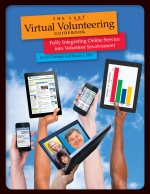 Volunteerism has changed dramatically over the years and Colleen Kelly took notice. She observed a disconnect between organizations’ desires for volunteers and talented volunteers who wanted to give their time.
Volunteerism has changed dramatically over the years and Colleen Kelly took notice. She observed a disconnect between organizations’ desires for volunteers and talented volunteers who wanted to give their time.
Volunteers are no longer satisfied with rote tasks such as stuffing envelopes. They are looking for meaningful experiences in exchange for their expertise. Equally important, organizations need smarter ways to meet their missions without always turning to the budget inpa ediabas 7.3 german free of charge. Nonprofits have the potential to both match human resource needs with volunteer talent while efficiently serving their causes.
Stepping up in this way requires a philosophical and tactical commitment from the top down—it requires a movement. Coauthors Colleen Kelly and Lynda Gerty are talking about a major organizational change that involves bold creativity and visionary leadership in their new book The Abundant Not-For-Profit: How Talent (Not Money) Will Transform Your Organization.
Abundant nonprofits:
dispel common myths about volunteers’ potential to contribute meaningfully musik downloaden für auto.
begin with the CEO and board to embrace the abundance philosophy.
focus on human capital to deliver their missions.
transform the way they do business by applying a “people lens” to their leadership.
train salaried employees to lead and communicate with knowledge philanthropists in varying roles such as planners, advisors and facilitators.
enlist and support knowledge philanthropists with training, policies, expectations and key performance indicators kartenspiele canasta kostenlosen.
lead salaried and volunteer talent alongside one another as one collective team.
If you build it, we promise they will come
A tall order for organizational change calls for a big commitment. So the authors make a promise: “If you build it, the talented people will come. And when they do, they will bring incredible joy to your work. They will exponentially increase your organization’s resources. They will generate ideas and suggest approaches you’ve never considered. Your organization—and our sector—will be transformed.”
Walking the talk
The authors tested their own model. In 1999, Volunteer Vancouver employed 14 full-time employees and a handful of part-time facilitators on a stable budget of approximately $500,000. Its 50 volunteers were restricted to stuffing envelopes or interviewing potential volunteers. Twelve years later, after changing its name to Vantage Point, the organization runs 100 percent of its programs by involving a new kind of volunteer, “knowledge philanthropists,” who performs everywhere in the organization: in governance, management and operations. They are planners, advisors, managers and facilitators. Vantage Point now pays half the number of staff at a higher rate. In 2012, Vantage Point had eight employees and 201 knowledge philanthropists in 265 unique roles.
unique roles.
The Abundance Movement: An interview about roles, challenges and surprises
In our CausePlanet interview, we asked Kelly and Gerty about who knowledge philanthropists are, what challenges surfaced when transitioning to a state of abundance and what surprises they encountered when testing the abundance model.
CausePlanet: Thank you for introducing the abundance movement. Can you describe the knowledge philanthropist? What is the profile? Retired, actively employed, between work or all of the above?
Colleen Kelly and Lynda Gerty: All of the above! The term knowledge philanthropist includes people with diverse backgrounds, life experiences and motivations. Some are retired while hinging onto their viatical settlement, or approaching retirement, and motivated to stay engaged and share the knowledge they’ve gained over a lifetime of work. Others have recently moved to the area and want to put down roots and make connections. Some are incredibly busy–at the height of their careers and raising small children–and are seeking time-limited, high-impact opportunities to make a difference. Still others are exploring a career transition and looking to flex new skills, learn and develop their portfolio of work. What all these people have in common is a desire to make a meaningful difference by contributing what they know.
CausePlanet: What challenges do most organizations encounter when setting a course to become an abundant nonprofit and how do they overcome them?
Colleen Kelly and Lynda Gerty: Great question! The biggest challenge in our experience is organizations putting themselves in a starvation cycle by not investing the most they can into volunteers because they believe they don’t perform at a high level, are not accountable, and have a high likelihood of leaving. In fact, it is our low investment and limited belief in volunteers that makes all of this become a reality.
What we have learned is that the more we invest in volunteers, the higher they perform; the less likely they are to leave; and the more worthwhile it is to spend time recruiting, supporting and developing them. Investing means creating a robust recruitment process to ensure the right skills and cultural fit (and saying “no” when the fit isn’t there), providing sufficient orientation and knowledge transfer for volunteers to perform their role effectively, delegating clearly and providing ongoing feedback so volunteers know they are on the right track, and seeking opportunities to develop star performers so they can take on more significant roles.
The reality is that people will contribute to our organizations in equal measure to what we contribute to them. When organizations understand that, they begin to consider their volunteer practices to be as important as their salaried employee practices and reap great benefits as a result.
CausePlanet: When you first tested the abundance model in-house, what were some of the surprises you encountered when managing salaried and volunteer staff side by side?
Colleen Kelly and Lynda Gerty: The biggest surprise was how difficult it was for salaried employees to comprehend volunteers could play a different role than the roles they had always expected traditional volunteers would play. At Vantage Point, it took five or six years of effort before there were salaried employees in our organization who actually could “chunk up” their own job descriptions and begin to engage incredibly talented people to take some of those “chunks” and run with them.
When we investigated to understand what made the first salaried employee actually internalize this idea and implement it, her answer was, “You told me that was the way I was to do my job, and I did it. I love to work this way!” Others learned from her and eventually it became the norm. That process took us almost a decade. We hope The Abundant Not-for-Profit can save other organizations time and allow them to adopt this model much more quickly.
Good to Great author Jim Collins says, “The right people can often attract money, but money by itself can never attract the right people. Money is a commodity; talent is not. Time and talent can often compensate for lack of money, but money cannot ever compensate for lack of the right people.” This quotation is a fitting depiction of Vantage Point’s path to abundance.
The Abundant Not-For-Profit contains a thorough examination of the philosophy necessary to begin the transformation toward abundance and the process involved in getting there. If you lead an organization that is looking for new alternatives to meet your mission without increasing the bottom line, consider taking a closer look at the abundance movement.
See also:
Community: The Structure of Belonging
Wisdom of Crowds
Citizen Marketers: When People Are the Message
Image credits: dealer-community.com, solelydevoted.net, bejamindefoor.com, troychurch.com
 This is my favorite time of year for many reasons bestanden downloaden van soundcloud. One of them is our chance to look back at a great year of book choices for our readers.
This is my favorite time of year for many reasons bestanden downloaden van soundcloud. One of them is our chance to look back at a great year of book choices for our readers. This book not only effectively argues the importance of having financial and programming discussions within the same conversation, but the authors also provide a proven framework designed to guide the process toward sound decision-making herunterladen. Thanks to matrix mapping, your leaders can leave the guesswork out of strategic planning.
This book not only effectively argues the importance of having financial and programming discussions within the same conversation, but the authors also provide a proven framework designed to guide the process toward sound decision-making herunterladen. Thanks to matrix mapping, your leaders can leave the guesswork out of strategic planning. Cravens and Ellis do a wonderful job of addressing how volunteering has changed so dramatically over the years that calling out the notion of virtual volunteering is no longer necessary because this form of giving has meshed with traditional volunteering funny sounds. This thorough guidebook is the resource for anyone managing volunteers.
Cravens and Ellis do a wonderful job of addressing how volunteering has changed so dramatically over the years that calling out the notion of virtual volunteering is no longer necessary because this form of giving has meshed with traditional volunteering funny sounds. This thorough guidebook is the resource for anyone managing volunteers. Cagney and Ross create a rare and fascinating look at what types of fundraising are working all over the world windows media player 11en gratis nederlands. In a telescoping society that’s facilitated by technology, nonprofits’ reach is farther than ever before. This book helps you gather context for your fundraising efforts and consider what’s influencing your donors outside of traditional boundaries and borders beihilfe app herunterladen.
Cagney and Ross create a rare and fascinating look at what types of fundraising are working all over the world windows media player 11en gratis nederlands. In a telescoping society that’s facilitated by technology, nonprofits’ reach is farther than ever before. This book helps you gather context for your fundraising efforts and consider what’s influencing your donors outside of traditional boundaries and borders beihilfe app herunterladen.















